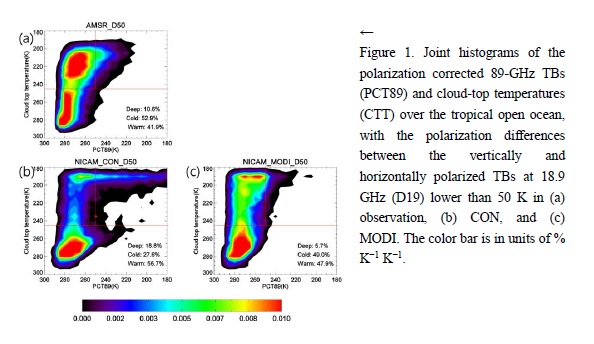Graphical Abstract
Roh, W., and M. Satoh, 2018: Extension of a multisensor satellite radiance-based evaluation for cloud system resolving models. J. Meteor. Soc. Japan, 96, 55-63.
https://doi.org/10.2151/jmsj.2018-002
Graphical Abstract with highlights
Highlights:
- A precipitation cloud evaluation method for cloud system resolving models are proposed using 11-μm brightness temperatures (TBs), high frequency microwave (89.0 GHz) TBs, and low frequencies (18.7 GHz) TBs over the ocean using satellite simulators (Fig. 1). This method can investigate precipitation clouds using two indexes, which represent the cloud-top height and large ice particle scattering intensity.
- The numerical results of the non-hydrostatic icosahedral atmospheric model (NICAM) with two cloud microphysics schemes were evaluated over the tropical open ocean using this method (Fig 1 b, c). The scattering intensities in both simulations at 89.0 GHz were different due to the parameterizations of the snow and graupel size distributions. A bimodal snow size distribution improved the TB underestimation at 89.0 GHz (Fig. 1 c).
- The impacts of nonspherical snow assumptions are investigated using a satellite simulator. The effect of a nonspherical snow shape in the radiative transfer model caused a small change in TBs at 89.0 GHz compared to the difference between the TBs of the two simulations without nonspherical assumptions.







